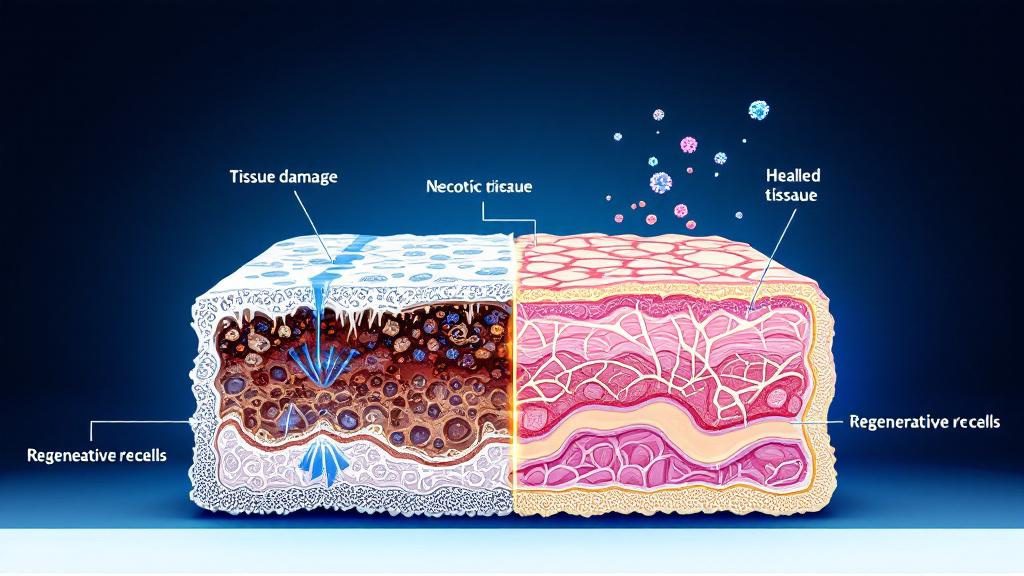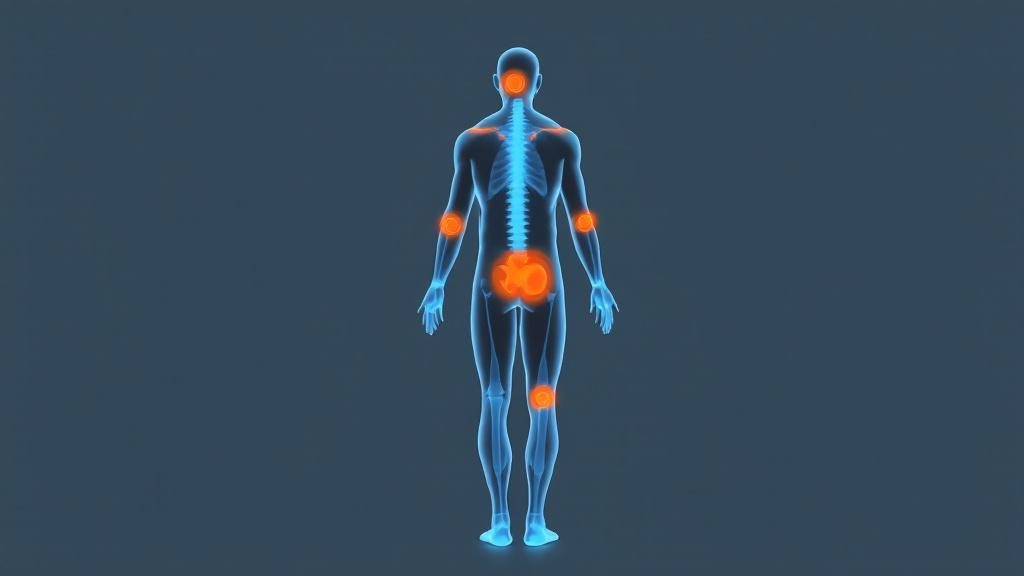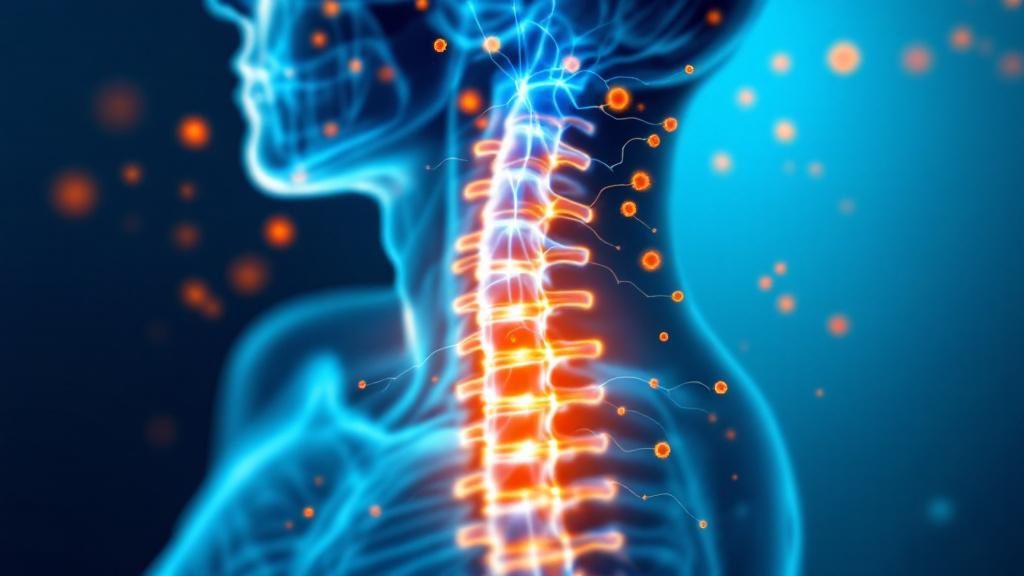Regenerative Medicine: A New Approach to Chronic Pain
Chronic pain is exhausting.
Not just physically. Mentally. Emotionally. It wears you down in ways that people who don't live with it will never understand.
You've tried everything. Medications that barely touch the pain. Physical therapy that helps for a while, then stops working. Injections that give you a few weeks of relief before everything comes roaring back.
You're told to "manage" your pain, as if accepting a lifetime of discomfort is the only realistic option.
But here's what most people don't realize: chronic pain isn't something you have to live with forever.
The traditional approach to chronic pain is fundamentally flawed. It focuses on masking symptoms instead of fixing the underlying problem. It treats pain as a condition to manage rather than a signal that something needs to be repaired.
Regenerative medicine flips that approach on its head.
Instead of covering up pain with medications or trying to trick your nervous system into not feeling it, regenerative medicine asks a better question: Why is your body still hurting, and what does it need to actually heal?
The answer to that question changes everything.
Why Traditional Chronic Pain Treatment Fails Most People

Let's be honest about how chronic pain is usually treated.
Step one: medications. Anti-inflammatories, muscle relaxers, pain killers. They work for a while, then you need higher doses. Side effects pile up. Your body builds tolerance. The pain breaks through anyway.
Step two: injections. Cortisone shots, nerve blocks, epidurals. They provide temporary relief by shutting down inflammation or blocking pain signals. But the underlying damage? Still there. So the pain comes back.
Step three: surgery. When everything else fails, you're told the only option left is to cut something out, fuse something together, or replace something entirely.
This entire system is built around one concept: symptom management.
Nobody's asking why your tissue is damaged in the first place. Nobody's helping your body repair what's broken. The focus is entirely on making you feel less pain, not on making you less damaged.
And that's why it fails.
Because as long as the tissue damage remains, your body will keep sending pain signals. You can block those signals temporarily, but you're not fixing the problem. You're just turning down the alarm while the house is still on fire.
The Cycle of Temporary Relief
Here's how the cycle goes.
You're in pain. You get treatment. The pain decreases. You feel hopeful.
Then, weeks or months later, the pain returns. Sometimes it comes back gradually. Sometimes it hits you all at once.
You go back for more treatment. More medications. More injections. More therapy sessions.
Relief. Return. Relief. Return.
This cycle exists because the treatment is addressing the symptom, not the cause.
Your body is still damaged. The tissue is still inflamed. The structural problem is still there. So of course the pain keeps coming back.
Regenerative medicine breaks that cycle by going after the root cause. It doesn't just reduce your pain—it repairs the damage that's creating the pain in the first place.
And when the damage is repaired? The pain doesn't come back.
What Makes Regenerative Medicine Different

Regenerative medicine operates on a completely different principle than traditional pain management.
Instead of blocking pain signals or suppressing inflammation, it helps your body rebuild damaged tissue.
Think about what chronic pain actually is. It's your body's way of telling you that something is wrong and needs attention. The pain isn't the problem—it's the signal that there's a problem.
Traditional treatment silences the signal. Regenerative medicine fixes what the signal is pointing to.
When you repair damaged tendons, ligaments, cartilage, or other soft tissue, the pain signal naturally decreases because there's no longer a reason for your body to send it.
This is why people who undergo regenerative medicine treatments often experience lasting relief. Not temporary, drug-induced relief that wears off. Actual, lasting improvement because the underlying damage has been addressed.
How Regenerative Therapies Target the Source of Pain
Chronic pain usually comes from one of a few sources.
Tissue damage. Torn ligaments, degraded cartilage, damaged tendons—when tissue is injured and doesn't heal properly, it becomes a constant source of pain and dysfunction.
Chronic inflammation. When inflammation doesn't shut off after an injury, it creates ongoing pain and prevents healing from progressing.
Nerve irritation. Damaged tissue can press on or irritate nerves, creating pain that radiates beyond the injury site.
Degenerative changes. Arthritis, disc degeneration, and other wear-and-tear conditions create structural problems that generate pain with every movement.
Regenerative medicine addresses all of these.
PRP therapy delivers concentrated growth factors that reduce inflammation and accelerate tissue repair. Stem cell therapy regenerates damaged tissue that your body can't fix on its own. Prolotherapy triggers controlled inflammation that restarts stalled healing processes.
The result? Your body stops hurting because it's no longer damaged.
Conditions Where Regenerative Medicine Excels for Chronic Pain

Regenerative medicine isn't a cure-all, but it's remarkably effective for specific types of chronic pain.
If you've been dealing with pain that stems from structural damage, tissue degeneration, or injuries that never fully healed, regenerative medicine might be exactly what you need.
Chronic joint pain is one of the most common targets. Knees, hips, shoulders, ankles—when cartilage breaks down and joints become inflamed, regenerative therapies can slow degeneration and rebuild tissue.
Tendonitis that won't go away responds incredibly well to PRP. Tennis elbow, Achilles tendonitis, rotator cuff tendinopathy—tendons heal slowly on their own, but PRP accelerates the process and restores strength.
Ligament injuries that leave joints unstable and painful can be addressed with regenerative treatments that strengthen and repair the damaged ligaments.
Degenerative disc disease in the spine is another area where regenerative medicine shows promise. While it can't reverse severe disc degeneration, it can reduce inflammation, improve disc hydration, and relieve chronic back pain.
Arthritis pain in its early to moderate stages benefits significantly from regenerative therapies. The goal isn't just pain relief—it's slowing the progression of joint breakdown and preserving function.
The common thread across all these conditions? They involve tissue damage that traditional medicine doesn't know how to repair. Medications can mask the pain. Surgery can remove or replace damaged parts. But regenerative medicine actually rebuilds what's broken.
Why Some Chronic Pain Doesn't Respond to Conservative Care
You've probably tried physical therapy. Chiropractic care. Exercise. Stretching. Diet changes.
And maybe those things helped to a degree. But the pain never fully went away.
That's not because conservative care doesn't work. It's because conservative care has limits.
Chiropractic adjustments can restore proper alignment and nervous system function, but they can't regenerate cartilage. Physical therapy can strengthen muscles and improve movement patterns, but it can't repair torn ligaments. Exercise can support joint health, but it can't reverse degenerative changes.
When the root problem is damaged tissue, conservative care can only take you so far.
That's not a failure of chiropractic or physical therapy. It's just the reality of what those treatments are designed to do. They optimize function and support your body's natural healing—but they don't replace missing tissue or repair structural damage.
Regenerative medicine fills that gap. It gives your body the tools to do what conservative care alone can't accomplish.
What to Expect from Regenerative Medicine Treatment

If you're considering regenerative medicine for chronic pain, you probably want to know what the process actually looks like.
Here's the reality: it's not instant. It's not magic. But it works.
Regenerative therapies take time to show results because they're helping your body rebuild tissue from the inside out. That's a biological process that can't be rushed.
Most people start seeing improvement within 4-6 weeks after PRP therapy. Stem cell treatments can take 2-3 months to fully integrate and show their effects. Some conditions require multiple treatments spaced weeks or months apart.
The timeline depends on how severe the damage is, how long you've been dealing with the problem, and how well your body responds to treatment.
But here's what's different from traditional pain management: the improvement is progressive and lasting.
With medications or injections, you feel better immediately, then the relief wears off. With regenerative medicine, you might not feel dramatic change at first, but over weeks and months, the pain decreases and function improves—and it stays improved.
The Treatment Process
Regenerative medicine treatments are typically done in-office and don't require surgery or general anesthesia.
For PRP therapy, a small amount of blood is drawn, processed in a centrifuge to concentrate the platelets, then injected into the injured area. The entire process takes about 30-45 minutes.
For stem cell therapy, the process depends on the source of the cells. If using your own bone marrow or fat tissue, there's a harvesting procedure followed by injection. If using donor-derived cells (like umbilical cord stem cells), there's no harvesting—the cells are prepared and injected directly.
After the injection, you might experience some soreness or swelling at the injection site. That's normal—it's part of your body's healing response.
Most people can return to normal activities within a few days, though you'll be advised to avoid intense exercise or heavy lifting for a short period to let the treatment take hold.
Follow-up appointments track your progress and determine if additional treatments are needed.
Realistic Expectations and Timeline
Regenerative medicine works, but it's not a one-size-fits-all miracle.
Some people experience dramatic improvement after a single treatment. Others need multiple sessions to achieve the results they're looking for. Some conditions respond quickly. Others take months.
The key is having realistic expectations and understanding that regenerative medicine is a process, not a quick fix.
If you've been dealing with chronic pain for years, your body isn't going to rebuild itself overnight. But over time, as tissue repairs and inflammation decreases, the pain will start to fade.
And unlike medications or injections that wear off, the improvement from regenerative medicine tends to be lasting. You're not just managing symptoms—you're actually fixing the problem.
That's what makes it worth the wait.
Regenerative Medicine vs. Pain Medication: A Better Long-Term Strategy

Let's talk about the elephant in the room: pain medications.
For a lot of people dealing with chronic pain, medication is the only thing keeping them functional. And there's no judgment in that. When you're hurting every single day, you do what you have to do to survive.
But long-term pain medication use comes with serious consequences.
NSAIDs (ibuprofen, naproxen) damage your stomach lining, increase your risk of heart attack and stroke, and can cause kidney problems with prolonged use.
Opioids are incredibly effective for pain relief, but they're also highly addictive, come with severe side effects, and lose effectiveness over time as your body builds tolerance.
Muscle relaxers make you drowsy, impair your cognitive function, and don't address the underlying problem—they just make your muscles stop reacting to the pain signal.
Pain medications have their place in acute injury management. But as a long-term strategy for chronic pain? They're a losing game.
Regenerative medicine offers a way out of that cycle. Instead of taking pills every day for the rest of your life, you address the tissue damage that's causing the pain. And when the damage is repaired, you don't need the medications anymore.
The Hidden Cost of Chronic Pain Medication
It's not just about side effects.
Pain medications change how your brain processes pain signals. Over time, your nervous system becomes hypersensitive. You need higher doses to achieve the same relief. The medications that used to work stop working.
This is called central sensitization, and it's one of the most frustrating aspects of chronic pain management.
Your body adapts to the medication, and suddenly you're stuck in a trap. You can't function without the medication, but the medication isn't working as well as it used to. So you increase the dose, which increases the side effects and the risk of long-term damage.
Regenerative medicine doesn't create that trap because it's not masking pain—it's eliminating the source of pain.
As your tissue heals, your nervous system recalibrates. Pain signals decrease naturally because there's no longer a reason for your body to send them. And your brain doesn't have to compensate for medication that's artificially blocking those signals.
The result? Lasting relief without the need for ongoing medication.
Why Regenerative Medicine Works Best Alongside Chiropractic Care

Here's something most people don't realize: regenerative medicine works better when your nervous system is functioning properly.
Your nervous system controls healing. It coordinates inflammation, directs blood flow, and regulates tissue repair. If your spine is misaligned and your nervous system is under stress, your body's ability to heal is compromised.
That's why combining chiropractic care with regenerative medicine produces better results than either approach alone.
Chiropractic adjustments optimize nervous system function, remove interference, and create an environment where healing can happen efficiently. Regenerative medicine delivers the biological tools your body needs to rebuild damaged tissue.
Together, they address both the neurological and structural aspects of chronic pain.
This is why having both services under one roof—like at Atlas Chiropractic and Regen and Restore—makes such a difference. Your care is coordinated. Your chiropractor and your regenerative medicine provider are communicating. Your treatment plan is comprehensive, not fragmented.
The Role of Nervous System Health in Healing
Your brain and spinal cord control everything in your body, including tissue repair.
When your spine is misaligned, it creates interference in the nervous system. That interference doesn't just cause pain—it slows down healing, increases inflammation, and reduces your body's ability to repair damaged tissue.
Chiropractic care removes that interference. Adjustments restore proper alignment, improve nerve communication, and allow your body to function the way it's designed to.
When you combine that with regenerative medicine, you're giving your body every possible advantage. Your nervous system is optimized. Your tissue is receiving concentrated healing factors. Both systems are working together instead of fighting against each other.
That's when real, lasting healing happens.
Is Regenerative Medicine Right for Your Chronic Pain?

Not everyone needs regenerative medicine. But if you've been dealing with chronic pain that hasn't responded to conservative care, it might be exactly what you need.
Here's how to know if you're a good candidate.
You've tried chiropractic care, physical therapy, and other conservative treatments, but the pain persists. That's a sign that tissue damage is the root problem, not just dysfunction or misalignment.
You're currently managing pain with medications, but you want to get off them. Regenerative medicine can address the underlying damage so you don't need to rely on pills every day.
You're facing surgery, but you want to explore non-surgical options first. Regenerative medicine offers a middle ground between conservative care and invasive procedures.
Your pain is affecting your quality of life, and you're ready to do something about it. If you're tired of just managing symptoms and you want actual healing, regenerative medicine might be the answer.
The best way to find out if regenerative medicine is right for you? Talk to a provider who specializes in it.
Regen and Restore in Sheridan works with patients dealing with chronic pain, degenerative conditions, and injuries that haven't healed. Because they're located in the same building as Atlas Chiropractic, your care stays coordinated and comprehensive.
Questions to Ask Yourself Before Starting Treatment
Before you move forward with regenerative medicine, take a moment to assess where you're at.
How long have you been dealing with this pain? If it's been months or years, conservative care alone probably isn't going to fix it. You need something that addresses the tissue damage.
What treatments have you already tried, and how did they work? If you've exhausted conservative options and the pain keeps coming back, regenerative medicine is a logical next step.
What are your goals? Do you want to get back to playing sports? Walk without pain? Sleep through the night? Be clear about what success looks like for you.
Are you willing to commit to the process? Regenerative medicine takes time. It's not a quick fix. If you're looking for instant results, this isn't the right approach.
But if you're ready to invest in actual healing instead of just symptom management, regenerative medicine can change everything.
The Bottom Line on Regenerative Medicine and Chronic Pain

Chronic pain doesn't have to be a life sentence.
For too long, people have been told that pain management is the only realistic option. Take your medications. Do your exercises. Learn to live with it.
That's not good enough.
Regenerative medicine offers a fundamentally different approach—one that addresses the root cause of pain instead of just masking the symptoms.
It's not magic. It's not instant. But it works.
By helping your body repair damaged tissue, reduce chronic inflammation, and restore function, regenerative medicine gives you a path to lasting relief.
And when you combine it with chiropractic care that optimizes your nervous system and supports your body's healing capacity, the results can be life-changing.
If you're tired of managing pain and ready to actually heal, it's time to explore what regenerative medicine can do.
Visit Regen and Restore to learn more about your options and take the first step toward a life without chronic pain.
You've lived with the pain long enough. Now it's time to fix what's broken.
Recent Blog Posts...
How Long Does Regenerative Medicine Take to Work?
Regenerative Medicine: A New Approach to Chronic Pain
Regenerative Medicine Options: PRP vs Stem Cells
When to Consider Regenerative Medicine Treatment
Living With Pain
Care of Concussions
Office Hours
2:00 PM - 5:30 PM
2:00 PM - 5:30 PM
Office Hours
2:00 PM - 5:30 PM
2:00 PM - 5:30 PM
Copyright 2025 | Atlas Chiropractic | All Rights Reserved | Website by iTech Valet






